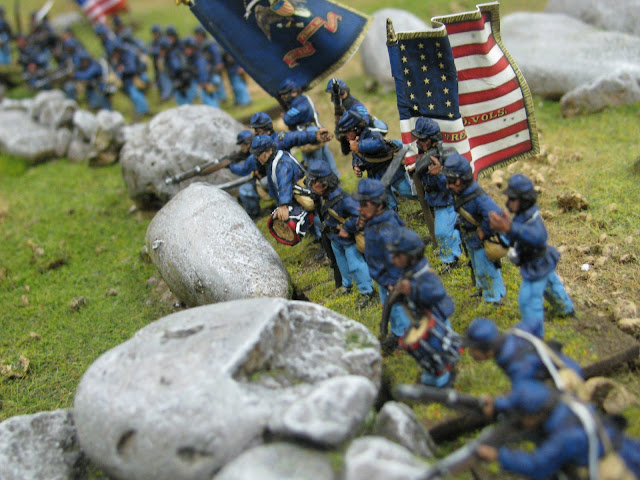Today at HistoriCon, I was reminded of what I like about the elegant miniatures game De Bellis
 |
| Pike refusing the flank against a knight charge |
Yesterday I mentioned that although I enjoy miniatures wargaming, it is not my primary interest, in no small part due to the great investment of time, money, and energy for what I consider to be a relatively sparse decision space over the span of a game. Well, DBA is the exception that proves the rule. The game requires only 12 stands of two to four miniatures for each army, plus campsites and some rudimentary terrain. In the 15mm scale, the game can be played on a two-foot-square playing area. Command-and-control limits are determined by a die roll at the start of each player's turn. Combat between two stands resolves with a single die roll by each opponent. After some familiarization, table look-ups even become unnecessary. A game is completed in typically an hour or less. So the investments of time and money both in preparation and the actual gameplay itself are minimal, although players can choose to make their armies and terrain as detailed, attractive, and realistic as they like.
This morning I got to participate in a demonstration of DBA 3.0, the next version currently in work by Phil Barker with the assistance of a number of dedicated playtesters. Demonstrators Bob Beattie and Tom Thomas have been involved in the project for months. The newest version remains true to the elegant nature of DBA but makes improvements to the behavior of certain troop types to better represent their historical application in battle. It also modifies the initial setup procedure and a few other aspects of the game.
Tom Thomas told me that they are finalizing the diagrams in the rules and expect to publish it in the next few months. Overall, I was impressed with the updates, but more to the point, just revisiting this old favorite brought back all the things I liked about playing DBA. I was even inspired to buy some scratch-built terrain at the convention flea-market.
GHQ Micro Squad
Ever since I first saw a micro-armor display at my first HistoriCon back in 2002, I've been fascinated by 1/285th-scale tanks. Some years ago, I dabbled briefly in some micro-armor gaming with the ruleset Spearhead, which was workable enough but which didn't gain traction in my gaming group. This afternoon, I tried out a micro-armor scenario set in North Africa between elements of the British 22nd Armoured Brigade and the Italian Ariete Armored Division using Micro Squad: The 1:1 Scale Game (designer George Christensen, publisher GHQ).
 |
| British (left) approach Italian defensive position |
I think the scenario might have been somewhat imbalanced from the standpoint that the British Crusaders had superior firepower and armor to the Italians, who did not number significantly more than the British. The Italians did have four anti-aircraft guns converted to long-range anti-tank rifles, which did an excellent job of protecting their right flank and inflicting a number of casualties. Those four guns did not, in my opinion, make up for the quality deficit that the Italians suffered. Even had my fellow player not pulled off such a brilliant flanking maneuver, I think the British would have prevailed on an attrition basis alone.
My impression of the GHQ Micro Squad rules is that the dice-rolling seemed a bit excessive. Every move or shooting action required a cohesion roll. In the case of shooting, every single tank that was intended to shoot would require a 20-sided die roll against its cohesion rating. Every tank that passed its cohesion test would then require a roll of two six-sided dice whose result would be modified based on terrain and other conditions and then entered into a table column based on a comparison between attack rating and armor. The result might be suppression and/or disorganization (which degrade cohesion) or elimination. Suppression and disorganization results could accumulate to result in elimination as well.
All in all, the combat system was workable, but the number of dice rolls required for, say, a line of eight tanks to fire at counterpart targets just seemed to make the game drag. When both sides have something like 30 tanks, and they've all lined up and started shooting at each other, that's a lot of dice to roll, one or two at a time, shot by shot. So if I ever go back into micro-armor, I'm not sure Micro Squad will be the rules I adopt. For all of that, however, it was still a fun battle.
Photo gallery
I had some free time between DBA and Micro Squad, so I wandered the game floor and took a few pictures of some of the more elaborate tables.
I want to make special mention of a display of Little Round Top, which attracted a lot of attention. The meticulous detail in the models and terrain is truly breathtaking. I hope these photos give some indication of the degree of dedication that some of these modelers put into this hobby.












No comments:
Post a Comment